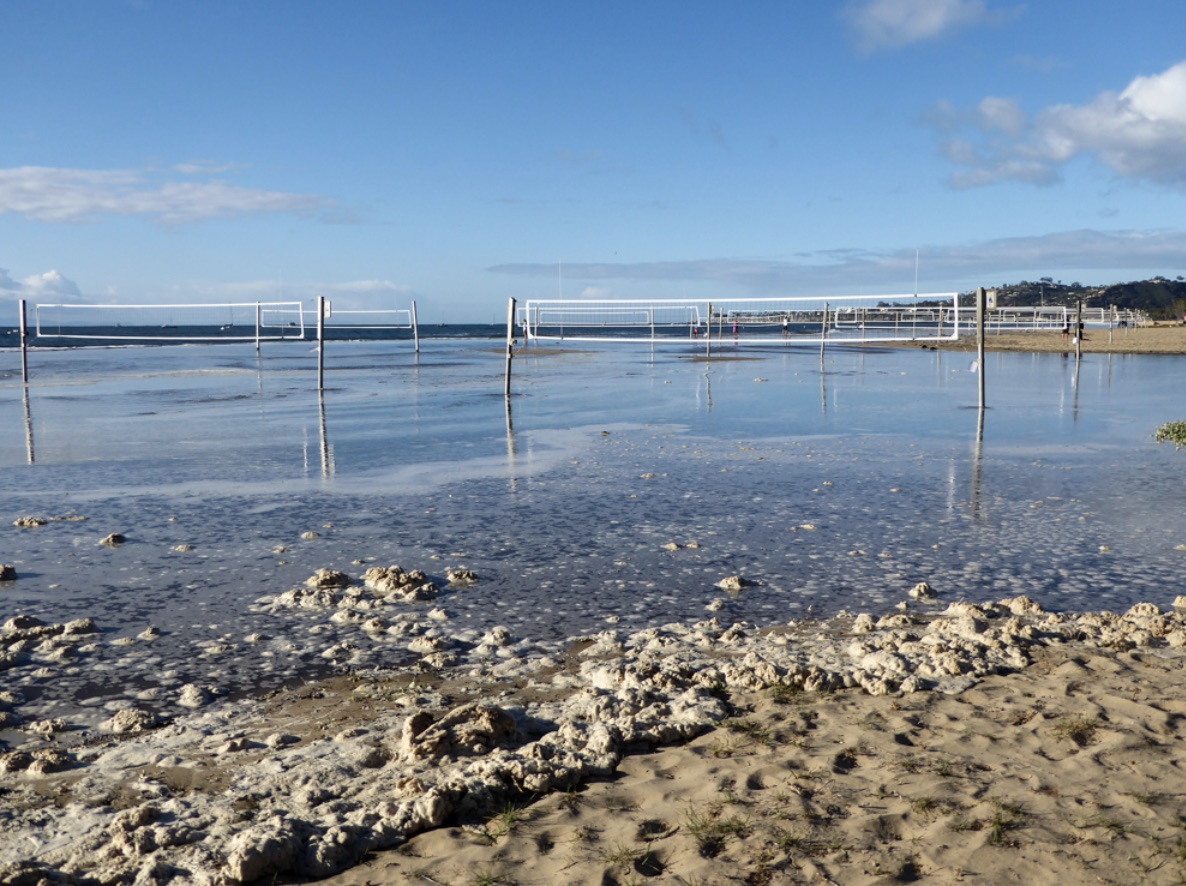East Beach — Not as Bad as You Think
Safe for Surfing if Only There Were Waves

BAD NEWS: Every now and again, you get something totally right and still get it totally wrong. A case in point: Last week, I wrote a news article detailing how Heal the Bay — a statewide clean-water watchdog — declared Santa Barbara’s East Beach belonged on their annual “Summer Bummer” list of the 10 most fecally compromised public beaches in California. This was the first time in 31 years East Beach — located at the confluence of Mission Creek and the Pacific Ocean — found itself on Heal the Bay’s wall of shame. The L.A. Times plastered this ignominious news about East Beach — as well as the rest of Heal the Bay’s report card — on its front page. The New York Times did the same. Naturally, I followed suit. If publications known alternately in better days as “the Gray Lady” and “the Velvet Coffin” were writing about dirty water in our beautiful, pristine Santa Barbara, who was I not to?
All this concentrated attention begged the much bigger question: Is there really such a told, by either P.T. Barnum or Oscar Wilde. Based on my empirical observations, I’d say the answer is no. The teeming throngs either don’t read or don’t care. Even after this carpet bombing of negative publicity, the intersection of State and Cabrillo remains one of the most heavily trod in all of Santa Barbaradom.
And who the hell swims down there anyway?
The story broke during the Fourth of July weekend, meaning it was next to impossible to get informed reactions from the public health officials and city bureaucrats whose job it is to make sure our beaches are kept safe at least where E. coli, Enterococcus, and total coliformcounts are concerned. These are the unholy trinityof bacterial indicators that suggest the presence of animal feces in the water. They are used to further suggest the possibility that the health of people swimming in such waters might be at some elevated level of potential risk.
Sign up for Indy Today to receive fresh news from Independent.com, in your inbox, every morning.
County Public Health officers test East Beach — and 15 other beaches in Santa Barbara County — every week all year. If they get readings that exceed thresholds established by the state legislature, public warnings are issued.
What those warnings mean and what value they offer is open to serious doubt and interpretation. They are akin, I suspect, to someone shouting “Watch out!” as you drive down the road but offering no helpful elaboration as to for what and from what direction it’s coming. In other words, our pineal freak-out gland gets activated, but the brain is left guessing.
For the record, East Beach experienced 18 exceedances in 2020. Those form the basis of its inclusion on the Summer Bummer list of 2021. The year before that, it experienced 19, but somehow it failed to make the Summer Bummer wall of shame. This year — 2021 — we’ve experienced just three. Typically at East Beach, any exceedance means it rained and that Sewer Lagoon had enough water, power, and flow to breach the sandbar blocking its mouth.
But how does knowing what happened a year ago help me decide whether it’s safe for me to go in the water today?
The problem is actually way more complicated. After my article had already run, I got around to interviewing Jill Murray of the city’s Creeks Division. Murray has a PhD in oceanography with a specialty in environmental microbiology. As a kid, she grew up in Los Angeles playing in an estuary that’s subsequently been diverted to the nearby neighborhood wastewater treatment plant for scrubbing. And she surfs. If East Beach had waves worth a damn, Murray said, she’d surf them in a heartbeat.
Murray’s problem with the Heal the Bay report isn’t so much that it reflects a reality that occurred a year ago; it’s that they’re measuring the wrong thing. The three bacterial indicators religiously tested by public health officials statewide suggest the presence of fecal matter originating in the gut of some unspecified mammal or bird. It does not indicate the extent to which the poop in question is of human origin. And that is key. The presence of human feces poses the possibility of serious health risk; seagull guano and dog poop, by contrast, most definitely do not.
Based on DNA analysis paid for by City Hall in conjunction with UCSB, we know the vast majority of the poop washing into the surf at East Beach originates with seagulls and dogs. That’s not a health problem. Beaches elsewhere in the state have spent millions steam-blasting their beach sand and stringing up vast spiderwebs of wires designed to keep gulls away. But who in their right mind wants to chase birds from the beach to eliminate a threat that poses no risk? Based on a recently released UCSB study involving 2,000 tests taken over a three-year period, we know that East Beach — by Sycamore Creek — tends to test positive for DNA markers indicating human waste. But these markers appear in such tiny amounts they can’t even be counted. What’s the cause? They ruled out homeless camps; they ruled out septic runoff from RVs that park nearby; they ruled out people pooping in the ocean at night; and, after injecting fluorescent dyes into nearby restrooms, they ruled out leaking toilet pipes. Their best guess? The more swimmers there were in the water, the researchers found, the higher the indicator counts were for “fecal shedding” of human origin. Swimming races had the highest counts.
By necessity, all reporters are dogs who cry wolf. It’s not so much an occupational hazard as it is our actual job. There’s only so much flight-or-fight stimulation any adrenal gland can tolerate. All the endless barking becomes noise and nuisance, not useful information.
In the meantime, maybe I’ll go swimming, but not at East Beach. Nobody swims at East Beach.
Sign Up to get Nick Welsh’s award-winning column, The Angry Poodle delivered straight to your inbox on Saturday mornings.



